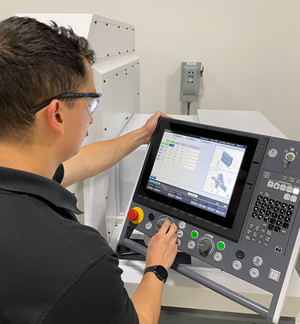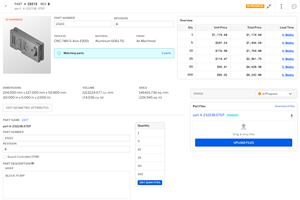OEE May Not Be Enough
Overall equipment efficiency (OEE) is a critical measurement of how well a manufacturing unit is doing. But shops should also focus on profitability, which is where Financial OEE comes in.
Share





Overall equipment efficiency (OEE) is considered a critical measurement of how well a manufacturing unit is doing. The formula is simple: It multiplies the percentages of availability, performance and quality to yield a single percentage. This result enables similar units (one machine, one department, one plant or an entire enterprise) to be compared or rated against a target such as a plant’s best record or a benchmark of world-class performance. Focusing on OEE enables manufacturers to pinpoint factors that hold back productivity.
Significantly, recent developments in data-driven manufacturing make calculating OEE easier, faster and more accurate—and acting on it more effective. For example, these benefits are an important advantage of connecting machine tools to a network for data collection and monitoring.
However, shops and plants must also focus on profitability. Managers have to balance decisions about maximizing the part-making capability of their equipment with decisions about the money-making potential of this equipment. OEE ratings alone provide an incomplete picture. One development that seeks to address this shortcoming is called Financial OEE (FOEE), a trademarked name for a new feature of MERLIN Tempus Enterprise Edition (EE) from Memex.
MERLIN (Manufacturing Enterprise Real-time Lean Information Network) is a communications platform for real-time manufacturing analytics. Tempus is the company’s suite of applications for machine monitoring such as real-time views of the plant floor, custom dashboards, reporting, alerting and other functions related to data-driven manufacturing. Tempus EE adds OEE, job scheduling and other modules such as FOEE.
Memex has partnered with noted OEE expert and author Robert Hansen to develop this approach. FOEE answers the question, “What is the value of improving OEE on this particular machine for this particular product?” More to the point, it answers “How much profit is being left on the table by not performing at company-best or industry-best levels for that specific part?” Thus, the FOEE concept shows the power of data-driven manufacturing and the Industrial Internet of Things to transform decision-making not only on the shop floor, but also in the front office.
Tempus EE automatically collects the event details necessary to compute OEE. The first phase of FOEE applies to stand-alone machines making a finished product. FOEE requires three key financial input values for each product and the machine. These inputs are unit sales price, unit material cost and the hourly operational expense (OPEX) of the machine. This information can be derived from the ERP product standard and the income statement.
FOEE is the current-state hourly profit divided by a value representing a world-class level of profit. This ratio tells a company what profit it made compared to what profit could have been made at world-class levels. With this information, a company can see the financial value of improving the machine’s performance.
In the figure on page 40, a product called P0006 is analyzed over 180 days. The product-run OEE data is correlated with the three inputs necessary for FOEE. It also associates important actionable data such as profit contribution per hour and current FOEE based on the machine’s best FOEE percentage, as well as how much more profit would accrue by running the machine at its best OEE rate.
With FOEE, managers can look at jobs scheduled for a machine and make decisions based not just on utilization, but also on utilization and profit. This enables managers to compare a list of machines capable of running a certain job, and to determine which machine would yield the highest hourly profit. Just as the OEE figure related to each project or job is a key tool in prioritizing and evaluating continuous improvement projects, FOEE provides a quick view of the profitability opportunity for these projects. FOEE is a tool to make better business decisions for scheduling products, guiding continuous improvement efforts and giving important feedback to sales and marketing teams.
Related Content
Swiss-Type Control Uses CNC Data to Improve Efficiency
Advanced controls for Swiss-type CNC lathes uses machine data to prevent tool collisions, saving setup time and scrap costs.
Read MoreProcess Control — Leveraging Machine Shop Connectivity in Real Time
Renishaw Central, the company’s new end-to-end process control software, offers a new methodology for producing families of parts through actionable data.
Read MorePrecision Shop Adopts Machine Monitoring, Boosts Revenue
Adopting machine monitoring helped LeClaire Manufacturing boost its vertical CNC utilization rates 38 percentage points and gain millions in revenue.
Read MoreGive Job Shop Digitalization a Customer Focus
Implementing the integrated digital technologies and automation that enhance the customer's experience should be a priority for job shops and contract manufacturers.
Read MoreRead Next
Last Chance! 2025 Top Shops Benchmarking Survey Still Open Through April 30
Don’t miss out! 91ÊÓƵÍøÕ¾ÎÛ's Top Shops Benchmarking Survey is still open — but not for long. This is your last chance to a receive free, customized benchmarking report that includes actionable feedback across several shopfloor and business metrics.
Read MoreMachine Shop MBA
Making Chips and 91ÊÓƵÍøÕ¾ÎÛ are teaming up for a new podcast series called Machine Shop MBA—designed to help manufacturers measure their success against the industry’s best. Through the lens of the Top Shops benchmarking program, the series explores the KPIs that set high-performing shops apart, from machine utilization and first-pass yield to employee engagement and revenue per employee.
Read MoreAMRs Are Moving Into Manufacturing: 4 Considerations for Implementation
AMRs can provide a flexible, easy-to-use automation platform so long as manufacturers choose a suitable task and prepare their facilities.
Read More


















